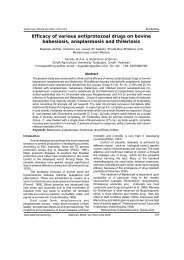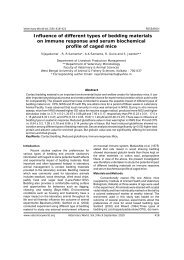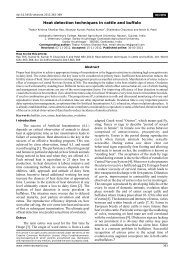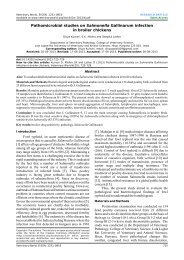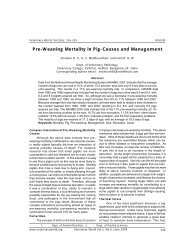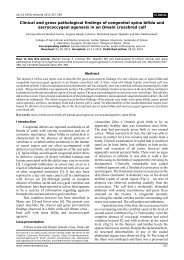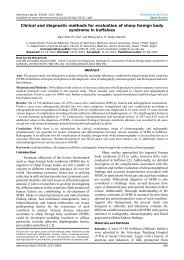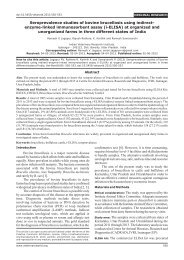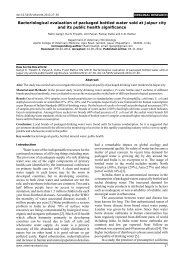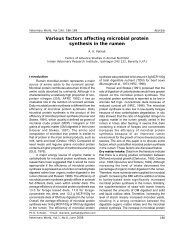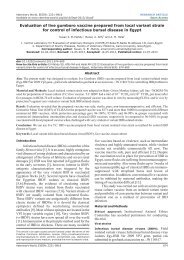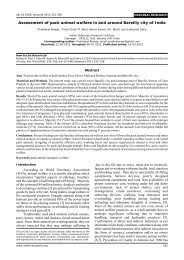In vitro Antibacterial activity of Pimpinella anisum ... - Veterinary World
In vitro Antibacterial activity of Pimpinella anisum ... - Veterinary World
In vitro Antibacterial activity of Pimpinella anisum ... - Veterinary World
You also want an ePaper? Increase the reach of your titles
YUMPU automatically turns print PDFs into web optimized ePapers that Google loves.
<strong>Veterinary</strong> <strong>World</strong>, Vol.1(9): 272-274 RESEARCH<br />
<strong>In</strong> <strong>vitro</strong> <strong>Antibacterial</strong> <strong>activity</strong> <strong>of</strong> <strong>Pimpinella</strong> <strong>anisum</strong> fruit<br />
extracts against some pathogenic bacteria<br />
<strong>In</strong>troduction<br />
A.Akhtar 1 , A.A.Deshmukh 2 , A.V.Bhonsle 3 , P.M. Kshirsagar 1 and M.A.Kolekar 4<br />
Department <strong>of</strong> Pharmacology and Toxicology,<br />
College <strong>of</strong> <strong>Veterinary</strong> and Animal Sciences, Udgir - 413517<br />
Maharashtra Animal and Fishery Sciences University, Nagpur-6<br />
<strong>Pimpinella</strong> <strong>anisum</strong> is a flowering plant in the<br />
family Apiaceae, native to the <strong>In</strong>dia and southwest<br />
Asia. It is a herbaceous annual plant growing to 1m<br />
tall. The leaves at the base <strong>of</strong> the plant are simple, 2-<br />
5 cm long and shallowly lobed, while leaves higher<br />
on the stems are feathery pinnate, divided into<br />
numerous leaflets. The flowers are white, 3 mm<br />
diameter, produced in dense umbels. The fruit is an<br />
oblong dry schizocarp, 3-5 mm long.<br />
As a medicinal plant, <strong>Pimpinella</strong> <strong>anisum</strong> has<br />
been used as a stimulating effect <strong>of</strong> digestion and<br />
antiparasitic, antifungal (Soliman and Badea, 2002)<br />
and antipyretic (Afifi,et.al.,1994). Additionally, the plant<br />
and especially its fruit essential oil have been used<br />
for treatment <strong>of</strong> some disease including seizures and<br />
epilepsy (Avicenna,1988;Abdul-Ghani,et.al.,1987).<br />
Furthermore, it has been shown to have<br />
anticonvulsant effects and has been used for the<br />
treatment <strong>of</strong> constipation (Curtis,et.al., 1996;<br />
Pourgholam,et.al., 1999; Chicouri and Chicouri, 2000)<br />
and possesses muscle relaxant effect<br />
(Albuquerque,et. al.,1995).Recently its oil has been<br />
reported to be used as antibiotic substitute in broiler<br />
ration (Mehmet,et.al.,2005).<br />
There are few reports (Singh,et.al.,2002;<br />
Tabanca,et.al.,2003) on systematic studies pertaining<br />
to antibacterial evaluation <strong>of</strong> <strong>Pimpinella</strong> <strong>anisum</strong>.<br />
Hence, considering its therapeutic potential, it was<br />
Abstract<br />
The antibacterial activities <strong>of</strong> the aqueous, 50% (v/v) methanol,acetone and petroleum ether extracts <strong>of</strong><br />
<strong>Pimpinella</strong> <strong>anisum</strong> (L) fruits were studied. The extracts <strong>of</strong> <strong>Pimpinella</strong> <strong>anisum</strong> were tested in <strong>vitro</strong> against<br />
4 bacterial species by the disc diffusion method. Staphylococcus aureus (MTCC 96), Streptococcus<br />
pyogenes (MTCC 442), Escherchia coli (MTCC 723) and Klebsiella Pneumoniae (MTCC 109) were used<br />
in this investigation. Only aqueous and 50% (v/v) methanol extract exhibited fair antibacterial <strong>activity</strong><br />
against all the test bacteria whereas acetone and petroleum ether extract were not observed to inhibit<br />
the growth <strong>of</strong> any <strong>of</strong> the test bacteria under study.<br />
Keywords: <strong>Antibacterial</strong> Activity, <strong>Pimpinella</strong> <strong>anisum</strong>, Pathogenicity, Bacteria<br />
essential to prove it for its exact rational use as<br />
medicine by scientific means. Therefore, the present<br />
investigation was undertaken to evaluate antibacterial<br />
<strong>activity</strong> <strong>of</strong> <strong>Pimpinella</strong> <strong>anisum</strong> dried fruits against some<br />
pathogenic bacteria.<br />
Material and Methods<br />
Fruits collection: The fruits <strong>of</strong> <strong>Pimpinella</strong> <strong>anisum</strong><br />
were purchased from the local market from three<br />
different sources. The materials were verified from<br />
Department <strong>of</strong> Botany, Maharashtra Udaygiri College,<br />
Udgir, district Latur, Maharashtra.<br />
Extraction: The fruits were shade dried and ground<br />
to powder form using the grinder mixer. Fifty gram<br />
dried fruits powder was soaked separately for 48 hrs<br />
in 200ml distilled water, 50% (v/v) methanols, acetone<br />
and petroleum ether for aqueous, alcoholic, acetone<br />
and petroleum ether extraction respectively. The<br />
soaked material was agitated at regular time intervals.<br />
After 48 hrs the soaked material was filtered using<br />
muslin cloth .Then the filterate were again filtered<br />
using whattman filter paper No 1. on separate filtration<br />
setups. The final filterates were collected in wide<br />
mouthed evaporating bowls and dried under room<br />
temperature. The dried extracts were weighed to<br />
calculate the extractability percentage. The extracts<br />
were stored at 40 C until further use.<br />
Bacterial panel: <strong>Pimpinella</strong> <strong>anisum</strong> fruits extracts<br />
were tested for antibacterial <strong>activity</strong> using a panel<br />
1. M.V.Sc. Students 2. Pr<strong>of</strong>essor and Head 3. Assistant Pr<strong>of</strong>essor 4. B.V.Sc & A.H student<br />
www.veterinaryworld.org <strong>Veterinary</strong> <strong>World</strong> Vol.1, No.9, September 2008<br />
272
<strong>In</strong> <strong>vitro</strong> <strong>Antibacterial</strong> <strong>activity</strong> <strong>of</strong> <strong>Pimpinella</strong> <strong>anisum</strong> fruit extracts against some pathogenic bacteria<br />
<strong>of</strong> Staphylococcus aureus (MTCC 96), Streptococcus<br />
pyogenes (MTCC 442), Escherchia coli<br />
(MTCC 723) and Klebsiella Pneumoniae (MTCC<br />
109).The organism were cultured and maintained on<br />
nutrient agar (MM012) and in Nutrient broth<br />
(M088).<br />
Antibiotic assay: Assays were performed as<br />
previously described (Bauer, et.al.,1966) with some<br />
modifications. <strong>In</strong> brief; each extract was pipetted onto<br />
a sterile paper disc (Hi Media Laboratories Ltd.,<br />
Mumbai, <strong>In</strong>dia) that had been suspended on top <strong>of</strong> a<br />
dissecting needle. The volume added was chosen<br />
because it represents the approximate volumetric<br />
capacity <strong>of</strong> each disc. The solvent was allowed to<br />
evaporate and the discs (upto 9 plate-1) were then<br />
placed onto the surface <strong>of</strong> Petri dishes that had<br />
previously been surface-inoculated with individual test<br />
strains at 10 6 dilution. Plates were then incubated at<br />
37°C for 24 hrs. Solvent control discs were prepared<br />
in the same manner and were never observed to<br />
inhibit bacterial growth. Cipro-floxacin discs, treated<br />
with 30 mg disc-1 <strong>of</strong> cipr<strong>of</strong>loxacin (Hi Media<br />
Laboratories Ltd., Mumbai), were used as antibiotic<br />
standards on each plate. Three replicate extracts,<br />
each from a sample <strong>of</strong> the same species <strong>of</strong> <strong>Pimpinella</strong><br />
<strong>anisum</strong> collected from three different sources, were<br />
assayed on different plates.<br />
After incubation, the diameter <strong>of</strong> clear zone<br />
surrounding the disc was measured to the nearest<br />
mm. An extract was considered active if one or more<br />
replicate extracts (each from a different fruit<br />
sample <strong>of</strong> the same species, but from different<br />
sources) produced a zone <strong>of</strong> inhibition >1 mm<br />
beyond the edge <strong>of</strong> the disc. The area <strong>of</strong> this zone<br />
<strong>of</strong> inhibition was calculated for each replicate assay<br />
<strong>of</strong> discs treated with extracts, and for<br />
cipr<strong>of</strong>loxacin discs, and mean and standard<br />
deviations calculated for all treatments. Because<br />
the disc diffusion assay is used to assess<br />
qualitative differences in antimicrobial <strong>activity</strong>, and<br />
is not without limitations (Jenkins, et. al.,1998),<br />
statistical analyses were not used to assign<br />
significance between treatments.<br />
Table2. Amount <strong>of</strong> different extracts impregnated on the discs<br />
Results and Discussions<br />
The percent extractability was highest for<br />
aqueous (18.16%) and lowest for petroleum ether<br />
(7.51%). The percentage extractability for 50% (v/v)<br />
methanol and Acetone were 12.22% and 9.08%<br />
respectively. (Table.1).<br />
Table1. Extractability Percentage <strong>of</strong> various<br />
solvent extracts<br />
Extract/Drug Extractability %<br />
Aqueous 18.16<br />
Acetone 9.08<br />
Petroleum Ether 7.51<br />
Methanol 12.22<br />
The amount <strong>of</strong> extract present on the disc<br />
prepared in Aqueous, Acetone, Petroleum ether, and<br />
50%(v/v) Methanol extract were 22.43±0.35,<br />
8.66±0.26,9.66±0.70 and 19.04 ± 0.74 respectively.<br />
The amount <strong>of</strong> extract impregnated on the disc was<br />
highest in aqueous and lowest in petroleum ether<br />
(Table 2). Therefore the amounts <strong>of</strong> different extracts<br />
impregnated on the discs were proportional to the<br />
percent extractability <strong>of</strong> the respective extract.<br />
The aqueous extract was found to be effective<br />
against all the pathogenic bacteria under test by disc<br />
diffusion assay. It exhibited fair antibacterial <strong>activity</strong><br />
against all the test bacteria. The petroleum ether and<br />
acetone extract failed to exhibit any zone <strong>of</strong> inhibition<br />
by disc diffusion assay. The 50% (v/v) methanol<br />
extract was found slight less effective than aqueous<br />
extract against all the pathogenic bacteria under test<br />
by disc diffusion assay. The reference drug<br />
(Cipr<strong>of</strong>loxacin) was more effective than all the<br />
<strong>Pimpinella</strong> <strong>anisum</strong> fruits extracts against all the<br />
pathogenic test bacteria when studied by disc<br />
diffusion assay (Table 3).<br />
The aqueous extract was found to be the most<br />
potent antibacterial extract, also the <strong>activity</strong> against<br />
both gram(+ve) and gram(-ve) bacteria suggest its<br />
potential use as a broad spectrum antibacterial agent.<br />
Further considering the cost, availability and<br />
extractability percentage <strong>of</strong> the aqueous extract, it<br />
can be considered & used as a cheap alternative to<br />
substitute antibiotics, especially in animal and poultry<br />
feeds.<br />
Extracts Weight <strong>of</strong> Blank disc Extract impregnated on disc Extract in each disc<br />
Aqueous 13.00± 0.00 35.42 ± 0.64 22.43 ±0.35<br />
Acetone 13.00± 0.00 21.66 ± 0.42 9.66 ± 0.70<br />
Petroleum ether 13.00± 0.00 22.26 ± 1.26 8.66 ± 0.26<br />
Methanol 13.00± 0.00 32.04 ± 1.10 19.04 ± 0.74<br />
www.veterinaryworld.org <strong>Veterinary</strong> <strong>World</strong> Vol.1, No.9, September 2008<br />
273
<strong>In</strong> <strong>vitro</strong> <strong>Antibacterial</strong> <strong>activity</strong> <strong>of</strong> <strong>Pimpinella</strong> <strong>anisum</strong> fruit extracts against some pathogenic bacteria<br />
Table3. Zone <strong>of</strong> inhibition <strong>of</strong> different extracts <strong>of</strong> fruit <strong>of</strong> plant <strong>Pimpinella</strong> <strong>anisum</strong> and reference<br />
drug against different bacteria<br />
References<br />
Extract/ Drug Mean Diameter + S.E (mm)<br />
E. coli S.aureus S. pyogenes K.Pneumoniae<br />
Aqueous 12.00+0.12 13.00±0.24 12.00±0.31 13.00±0.34<br />
Acetone No Zone No Zone No Zone No Zone<br />
Petroleum Ether No Zone No Zone No Zone No Zone<br />
Methanol 11.00±0.11 8.00±0.12 11.00+0.20 9.00+0.12<br />
Cipr<strong>of</strong>loxacin 34.00±0.24 33.00±0.24 30.00+0.14 28.00+0.47<br />
1. Abdul-Ghani, A.S., S.G. El-Lati, A.I. Sacaan<br />
and M.S.,Suleiman, (1987): <strong>In</strong>ternational J.<br />
Crude Drug Res., 25: 39-43.<br />
2. Afifi, N.A., A. Ramadan, E.A. El-Kashoury and<br />
H.A. El-Banna, (1994): Vet.Med. J. Giza, 42:<br />
85-92.<br />
3. Avicenna, A., (1988): Drugs and decoctions<br />
used in epilepsy. <strong>In</strong>: Sharafkandi, A.<br />
(Translator), Ghanoon Dar Teb. Soroosh Press,<br />
Tehran, pp: 456-459.<br />
4. Albuquerque, A.A., A.L. Sorenson and J.H. Leal<br />
Cardoso, (1995): J. Ethnopharmacology, 49:<br />
41-49.<br />
5. Bauer, A.W., et.al. (1966): Am. J. Clin. Pathol.<br />
45:493-496.<br />
6. Chicouri, M. and I. Chicouri, (2000): Novel<br />
pharmaceutical compositions containing senna<br />
with laxative effect.Fr. Demande FR 2791892<br />
A1, Oct 13, 6 pp.<br />
7. Çabuk, M., A. Alçiçek, M. Bozkurt and N. Imre,<br />
(2003): Antimicrobial properties <strong>of</strong> the<br />
essential oils isolated from aromatic plants<br />
and using possibility as alternative feed<br />
additives. II. National Animal nutrition<br />
Congress. 18-20 September, pp: 184-187.<br />
8. Jenkins KM, Jensen PR, Fenical W (1998):<br />
Bioassay with marine organisms: Part 11.<br />
Marine microbial chemical ecology. <strong>In</strong>: Haynes<br />
K, Millar JC (eds) Methods in chemical ecology<br />
Chapman and Hall, New York, p 1-32<br />
9. Mehmet Ciftci, Talat Güler, Bestami Dalkiliç<br />
and O. Nihat Ertas(2005): <strong>In</strong>ternational<br />
Journal <strong>of</strong> Poultry Science 4 (11): 851-855.<br />
10. Soliman, K.M. and R.I. Badea, (2002): Food<br />
Chem. Toxicol., 40: 1669-75.<br />
11. Singh, G., I.P. Kapoor, S.K. Pandey, U.K. Singh<br />
and R.K. Singh, (2002): Phototherapy Res.,<br />
16: 680-2.<br />
12. Tabanca, N., E. Bedir, N. Kirimer, K.H. Baser,<br />
S.I. Khan, M.R. Jacob and I.A. Khan, (2003):<br />
Planta Medical, 69: 933-938.<br />
****<br />
Camphylobacteriosis from consuming unpasteurised<br />
milk in California, USA<br />
Alexandre Family EcoDairy Farms ended its raw milk supply after several people who consumed the<br />
product got sick, including a Crescent City woman who remains in intensive care and is partially paralyzed. The<br />
Del Norte County Department <strong>of</strong> Public Health suspects at least 15 people who ingested raw milk contracted<br />
campylobacteriosis, a common bacterial infection found in domesticated animals that can cause gastrointestinal<br />
illness in people. Raw milk essentially comes straight from the udder and has become popular among healthconscious<br />
consumers. It is unpasteurized, and advocates say it contains beneficial microbes that help in digestion<br />
and provide increased nutrition. About 115 people were signed up for Alexandre EcoDairy’s raw milk supply<br />
program.<br />
It is illegal to sell raw milk in California , but it is not illegal to get it from your own animal. The Alexandres<br />
devised a cow-share program that allowed people to buy stock in an Alexandre cow. That gave them personal<br />
ownership <strong>of</strong> the animal and allowed them to legally take raw milk from Alexandre EcoDairy. Before customers<br />
could join the cow-share program and get the raw milk, Alexandre gave them a 3-ring binder full <strong>of</strong> information.<br />
<strong>In</strong> the 1st section are a number <strong>of</strong> articles relaying the dangers <strong>of</strong> consuming raw milk. To join the cow-share<br />
program, customers signed an agreement relieving the eco-dairy <strong>of</strong> liability in case <strong>of</strong> health problems caused<br />
by raw milk. Raw milk is a well-documented source <strong>of</strong> infections from Salmonella, E. coli O157:H7, Campylobacter,<br />
Listeria, Mycobacterium bovis, and other pathogens.<br />
www.promedmail.org<br />
www.veterinaryworld.org <strong>Veterinary</strong> <strong>World</strong> Vol.1, No.9, September 2008<br />
274



